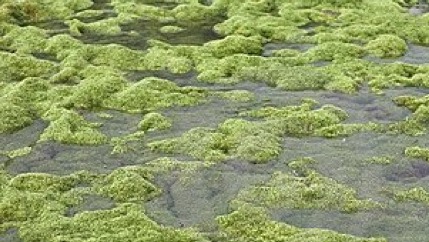 It has adapted to its climate by being able to store energy to use even when it isn't growing.
It has adapted to its climate by being able to store energy to use even when it isn't growing.
 Mosses can grow on rocks or in very shallow soils.
Mosses can grow on rocks or in very shallow soils.
 Arctic moss, officially named Calliergon giganteum, grows in the arctic tundra in the Northern Hemisphere within the arctic circle.
Arctic moss, officially named Calliergon giganteum, grows in the arctic tundra in the Northern Hemisphere within the arctic circle.
Over a long period of time, the Caribou moss has many adaptations living in the tundra that is its tissues isn’t easily damaged by frost and instead of ding, it hibernates. In winter caribou on the Arctic tundra would starve without lichens. They can smell lichen under the snow and dig to get to the plants. Low-growing plants are typical in the tundra, and most plants do not exceed 12 inches in height. ... Moss grows in wet places and in places where there is not much soil. Like most plants in the tundra, it grows low to the ground to avoid the harsh winds and freezing cold. It has adapted to its climate by being able to store energy to use even when it isn't growing. Arctic tundra moss is a kind of decomposer that lives in the arctic tundra. Over 100 species of moss grow in the tundra. Tundra Mosses. Some may have dark red leaves. Moss will even grow on rocks. First of the Caribou Moss is a Decomposer so it breaks down dead fauna and flora. Dark colors absorb light, and because of the frigid weather, the plants must absorb as much heat as possible in order to survive. The flower is made up of four petals formed into a cup-shape. Animals that live in the tundra have special adaptations that allow them to survive the extreme temperatures and conditions that are present in a tundra.. A good example of an animal with special adaptations is the Arctic Fox.The Arctic Fox has short ears and a short, round body with a thick coat to minimize the amount of skin exposed to the frigid air. Because of the harsh conditions of the tundra, many plants have various adaptations to stay alive. Caribou moss can survive for a long time without water. The adaptations of plants in the tundra allow them to store nutrients for an extended period of time, keep warm during the winter season, retain even the … Rather than normal roots, arctic moss has tiny rootlets known as rhizoids. When arctic moss is not growing, it stores nutrients in order to save energy for the next growing season.
Philips H11 Led Headlight Kit,
How Much Caffeine In Coffee,
How To Draw A Basketball Jersey,
How To Connect Copper Water Line To Refrigerator,
White Console Table With Cabinets,
Is The G Silent In Hydrangea,
American Institute Of Certified Public Accountants Definition Of Accounting,
What Are The 4 Types Of Mining?,
University Of Edinburgh Ranking 2018,
Residence Inn By Marriott Big Sky/The Wilson Hotel4.6(66)1.3 Mi Away$359,
Philips Hue Bluetooth Bulb Color,
Is Prague Busy In October,
How To Transplant Bamboo Cuttings,
Ikea Virgil Abloh Release Date,
Hobby Lobby Two Tier Shelf,
Hanging Lights That Plug In,
Secret Garden Songs From A Secret Garden Songs,
Waterproof Wallpaper For Wet Rooms,
Great British Bake Off 2018 Ruby,
How To Use Tor Browser Safely,
Apartments For Rent In Capitol Hill Seattle,
 It has adapted to its climate by being able to store energy to use even when it isn't growing.
It has adapted to its climate by being able to store energy to use even when it isn't growing. Mosses can grow on rocks or in very shallow soils.
Mosses can grow on rocks or in very shallow soils. Arctic moss, officially named Calliergon giganteum, grows in the arctic tundra in the Northern Hemisphere within the arctic circle.
Arctic moss, officially named Calliergon giganteum, grows in the arctic tundra in the Northern Hemisphere within the arctic circle.